Please scroll to the bottom of the page for the English version.
12月から執筆している創業285年「誉田屋源兵衛」十代目山口源兵衛さんへのインタビュー第一弾と第二弾。さらに第三弾では「誉田屋源兵衛」の国宝レベルの奇跡の帯たちの詳細をご紹介しました。
最終章となる第四弾では前回紹介しきれなかった「想像を絶する美しい帯たち」「国宝級のスキルを持つ職人たちが失われてく現実」「着物姿は帯姿、帯が持つ本来の意味」についてお伝えしていきます。
源兵衛さんは国内外に熱狂的信奉者がいらっしゃり、受け継がれてきた技術と伝統を引き継ぎながら、着物業界に「革新」を起こすような作品を次々と発表されています。「帯業界の異端児」と言っても過言ではありません。
「誉田屋源兵衛」オフィシャルウェブサイトはこちら。 https://kondayagenbei.jp
昨年11月の帰国時に様々な奇跡が重なり、国宝レベルの帯たちを直接見せていただくうえに、源兵衛さんへインタビューを行う大変貴重な機会に恵まれました。
第一弾 創業285年帯匠「誉田屋源兵衛」源兵衛さんインタビュー記事①→ https://ayakanoikigaidou.com/post-5026/
「教科書には載っていない日本の歴史」「物事を複雑化しすぎる現代人」「観光地ではない本当の京都と日本の文化」
第二弾 創業285年帯匠「誉田屋源兵衛」源兵衛さんインタビュー記事②
→ https://ayakanoikigaidou.com/post-5241/
「源兵衛さん自身のお寺での修行のお話」「親友 田中泯さんとの出会い」「源兵衛さんの意外なご趣味」
第三弾 創業285年帯匠「誉田屋源兵衛」想像を絶する奇跡的な帯たち in 京都①
→ https://ayakanoikigaidou.com/post-5351/
- ボストン美術館に保管されている水墨画を表現した2本の帯
- 日光東照宮の暗闇で見た牡丹をラピスラズリで表現した帯
- 徳川十一代目家斉公の紋様を施した帯
- 日々表情を変えていく帯と永遠に変らない帯
- 一階フロアに展示されていた国宝レベルの帯たち
- 着物姿は帯姿、帯が持つ本来の意味とは?
- 国宝級のスキルを持つ職人たちが失われてく現実
- 日本人として母国のために自分が出来ること
- Final Chapter: Unprecedented Miraculous Obi Creations by the 285-Year-Old Obi Craftsman, ‘Kondaya Genbei,’ in Kyoto (Part 2)
- Two Obis Depicting Ink Paintings Preserved at the Boston Museum of Fine Arts
- An obi belt that captures the image of peonies seen in the darkness of Nikko Toshogu Shrine, rendered in lapis lazuli
- An obi belt adorned with the crest of the eleventh shogun of the Tokugawa era, Ienari Tokugawa
- An obi belt that evolves and changes its expression daily, alongside a belt that remains eternal and unchanging
- Belts of national treasure caliber exhibited on the first floor
- The attire of a kimono involves the style of the obi, and what is the inherent meaning of the obi?
- The harsh reality is the loss of artisans with national treasure-level skills.
- What I Can Do as a Japanese for My Homeland
ボストン美術館に保管されている水墨画を表現した2本の帯
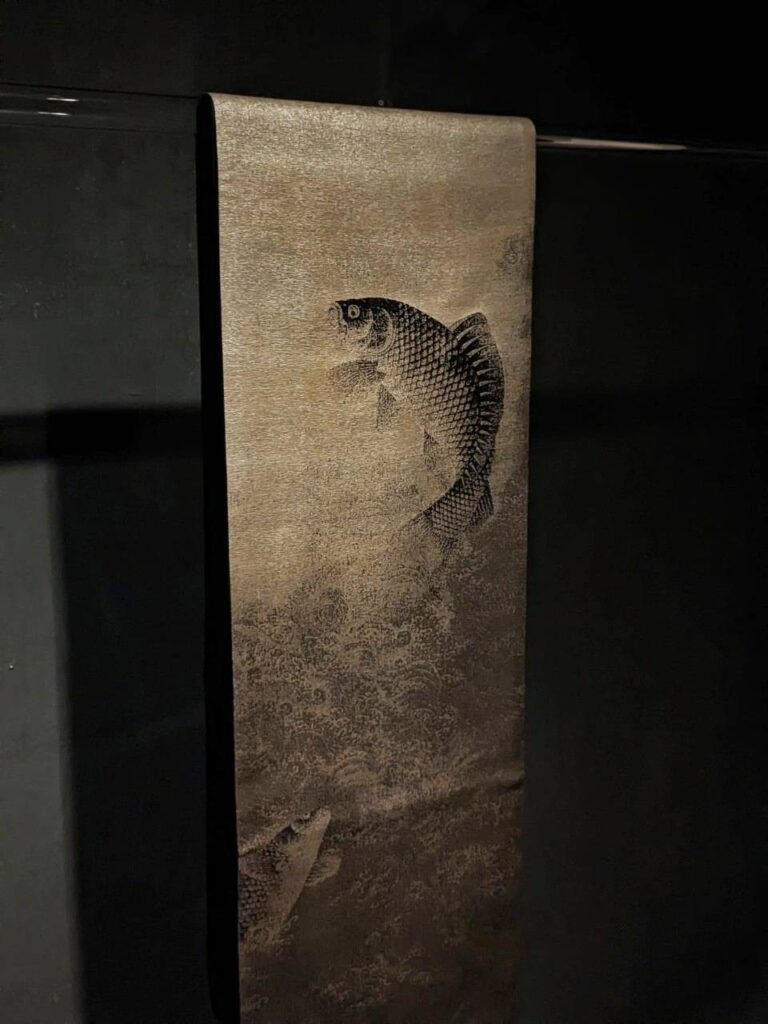
こちらはボストン美術館に原画が保管されている、中国の明時代の水墨画を帯で表現したものです。
織物でどこまでその美しい水墨画以上のものを織れるかという挑戦だったそう。こちらの帯には約100年の歳月を経て硫化した銀が使用されています。さらに水墨画を表現するため濃淡をつけながら墨で糸を染めたものが織り込まれています。鯉の鱗のみに漆で染めた糸使用されているので、漆の輝きが垣間見えます。
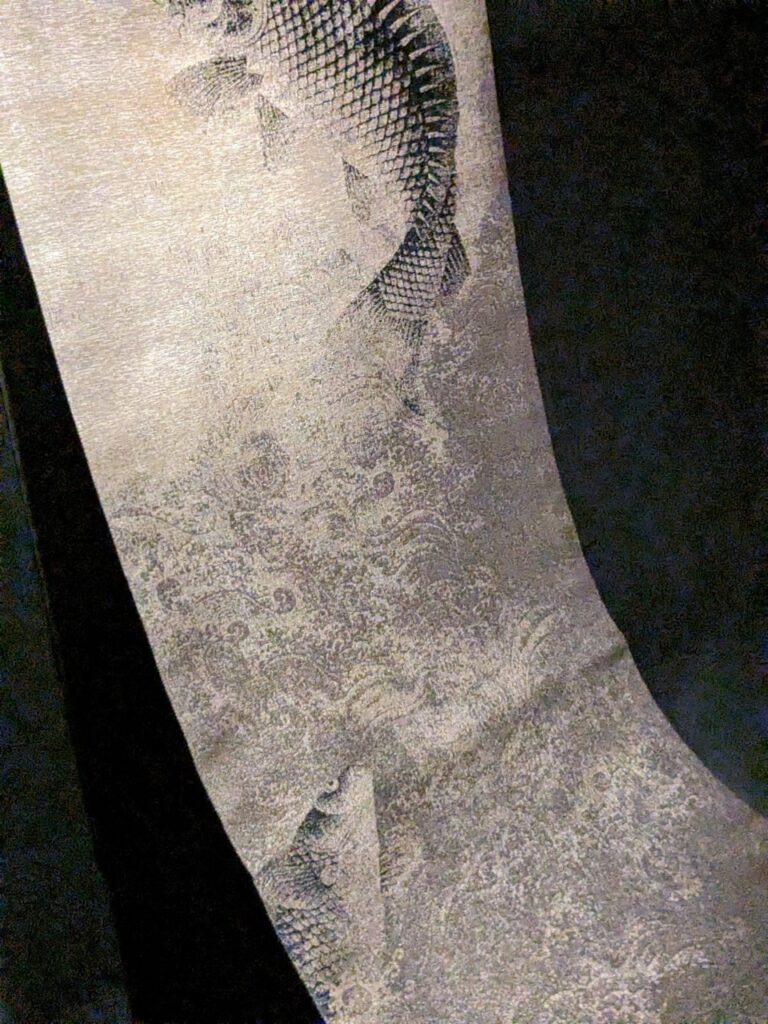
波一つ一つも織り上げられています。想像ができないほど緻密で繊細な織物です。
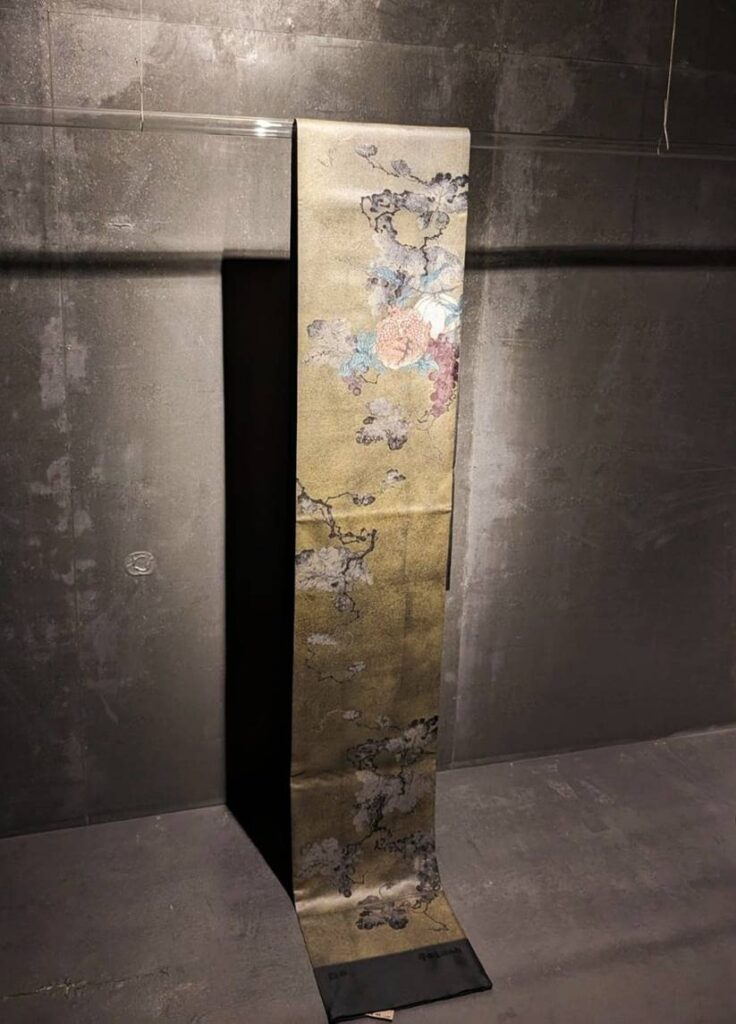
そしてこちらもボストン美術館に保管されている中国の水墨画の表現に挑戦した帯です。
「美術品としては水墨画が究極で最高だ」というのが源兵衛さんの考えだそう。だからこそどこまで究極の美術品を織物で表現できるのかという挑戦をしているわけです。
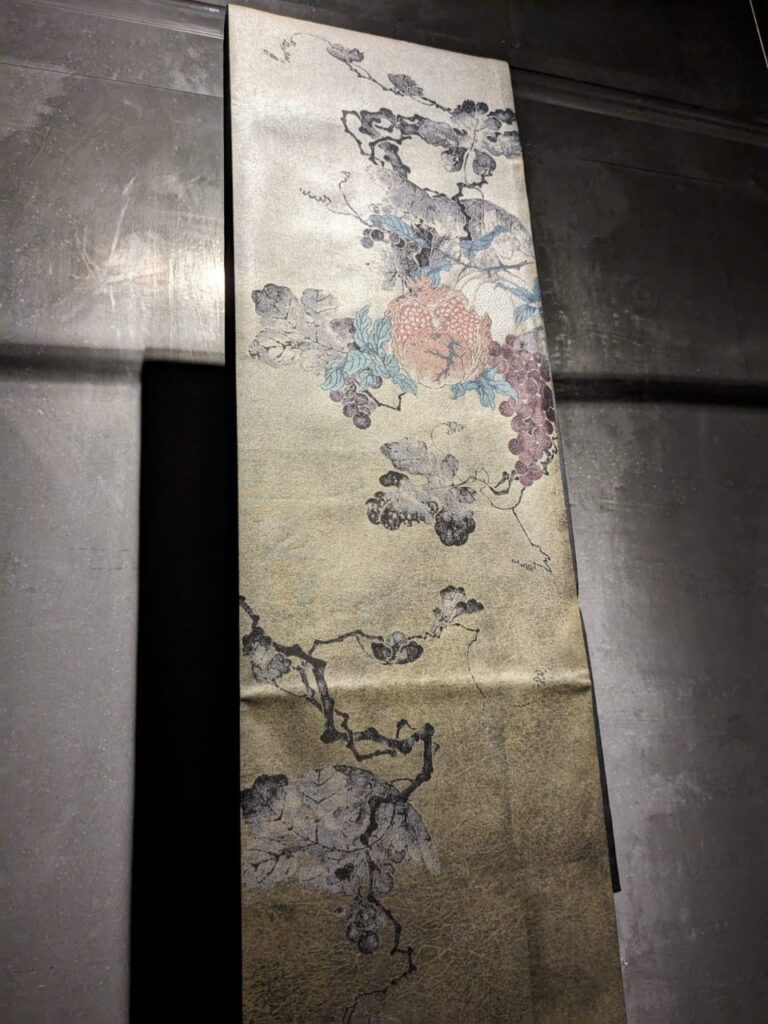
こちらの帯も約100年の歳月を経て硫化した銀をベースに使用しています。
銀の特徴は、始めは綺麗な銀色が時を経て、金色や緑、オレンジ系が出たり変色しながら最終的に黒くなっていくことです。銀ならではの変化の過程を味わうことができるのがこちらの水墨画を表現した2本の帯です。
今後さらに100年経ったら、さらに黒っぽくなりまた渋い味わいが出るわけです。
人間が歳を重ねるとともに、帯にも深みと味が増す。まさに帯が生きているようです!
日光東照宮の暗闇で見た牡丹をラピスラズリで表現した帯
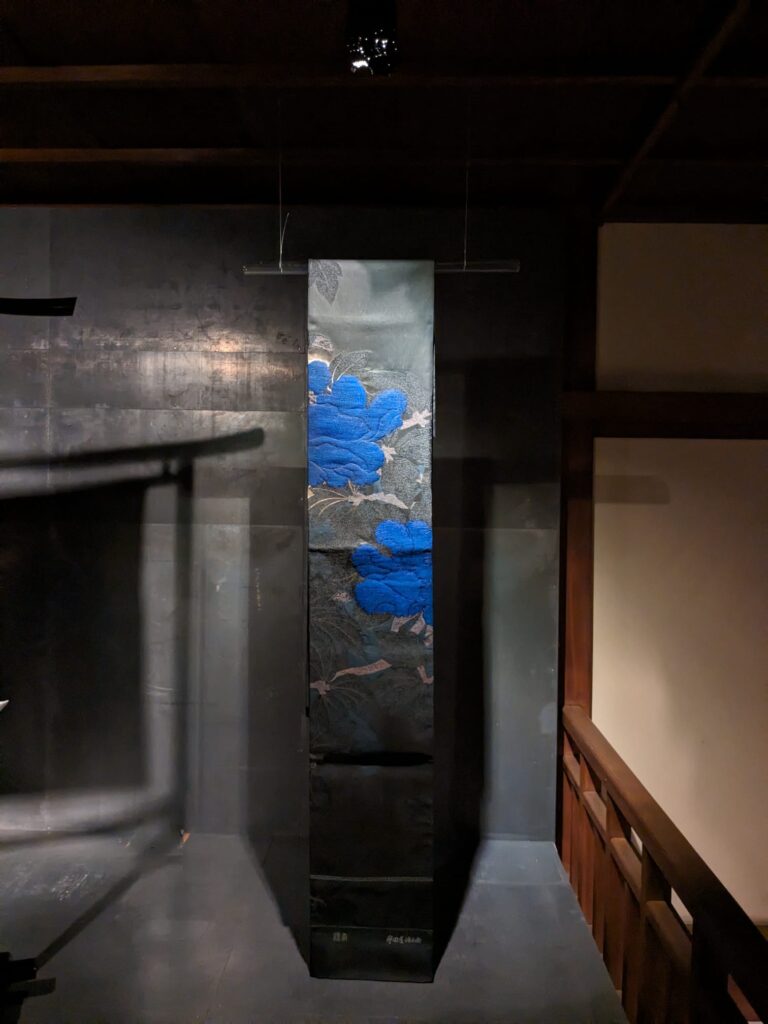
私が源兵衛さんのことを知ったのは、パートナージョセフが源兵衛さんのこちらの帯の動画をYou Tubeで見つけたのがきっかけ。この帯を見た瞬間に虜になりました。
日光東照宮の普通は入れない特別な所でみた暗闇の牡丹を表現した帯です。若干の月明かりを表現するために銀をあえて残しているそう。織り込まれた青い牡丹にはラピスラズリが使われています。
徳川十一代目家斉公の紋様を施した帯

こちらの帯は和紙を漆で染めて、重ね塗りしたあとに細い糸状に裁断し、網代の文様を織り込んだ帯です。普通は漆は固くなりますが、柔らかく仕上がっているのは、和紙に染めて細く切ったものを織り込んでいるからです。


実は漆も100年200年経つと枯れてさらに深みが出てくるそうです。破れ扇の部分は、プラチナと24金が使用されています。
破れ扇は徳川十一代目家斉公の陣羽織の柄で「どれだけ破れても決して諦めない。何があろうが自分が責任をとる」という精神の紋様だそうです。それを自分の覚悟で陣羽織に入れていたわけです。本当に粋ですよね。
日々表情を変えていく帯と永遠に変らない帯
銀や第三弾でご紹介した柿渋で染めた帯は、歳月を経て変わっていきます。今日と明日で少しずつ帯も変化する。まさに「一期一会」の帯です。
逆に、金閣寺がずっと輝いているのと同じようにプラチナ、24金とシェルは変らないそう。前回ご紹介した「貝殻を使用して、超人的な繊細な技法で作られた帯」「プラチナで伊藤若冲の作品を表現した帯」がまさに変わらない帯。
「日々変わっていく美しさ」と「永遠に変わらない美しさ」が帯で堪能できるなんて、なんて素敵なんでしょう!
一階フロアに展示されていた国宝レベルの帯たち
ここまでご紹介した帯たちは「誉田屋源兵衛」の二階に展示されてたもの。それだけで目も胸もいっぱいでしたが、一階のフロアにも国宝級の帯がずらりと並んでいました。順番にご紹介していきます。
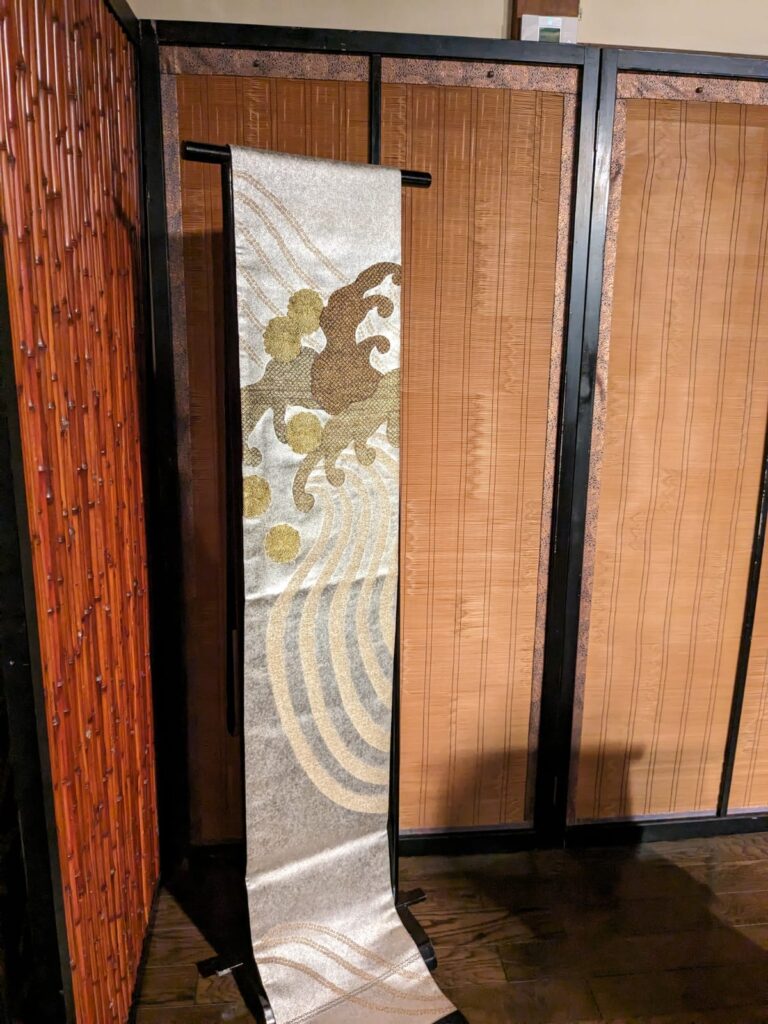
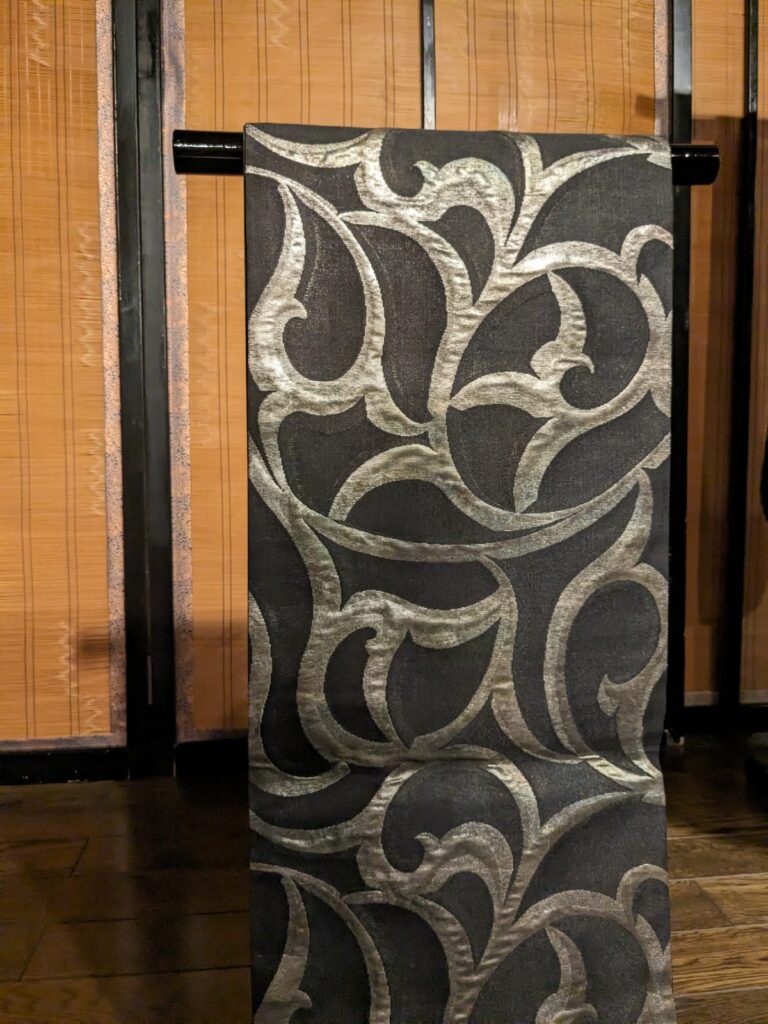
(左)ベースは約100年前の銀を使用。手前の紋様は金を使用。
(右)ルネ・ラリック(19世紀から20世紀に活躍してフランスのジュエリー作家、ガラス工芸家)のガラスの器のつむじ風文様を帯で表現。立体的になるように、中に柔らかい絹の綿を中に織り込みながら織っています。
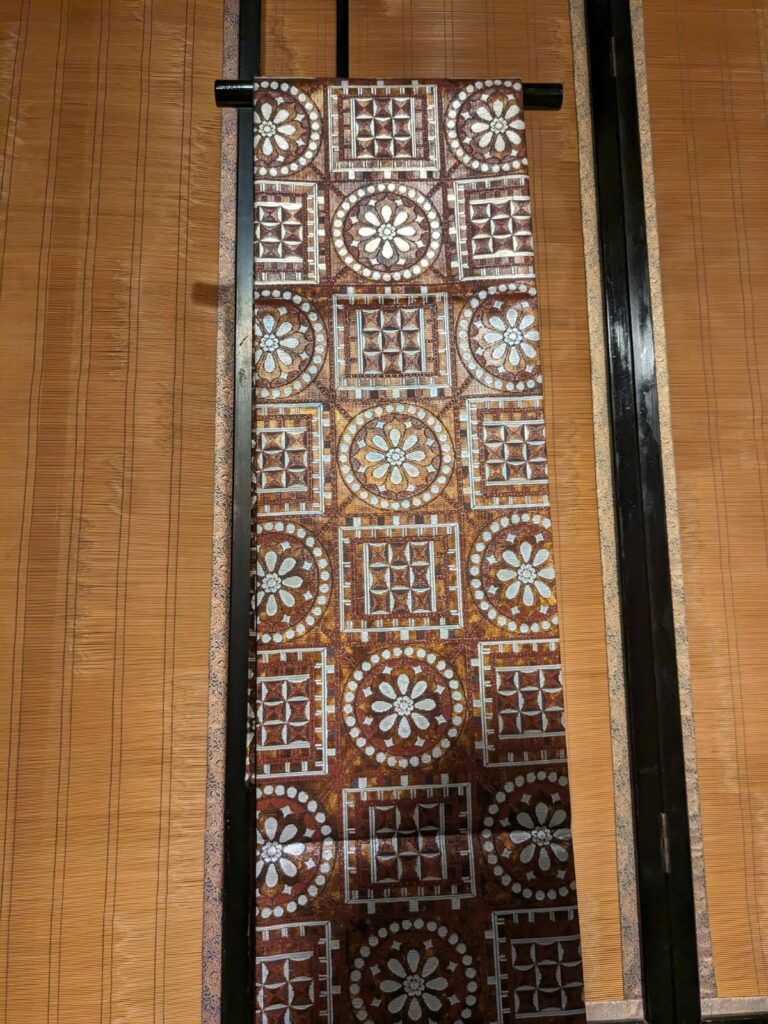
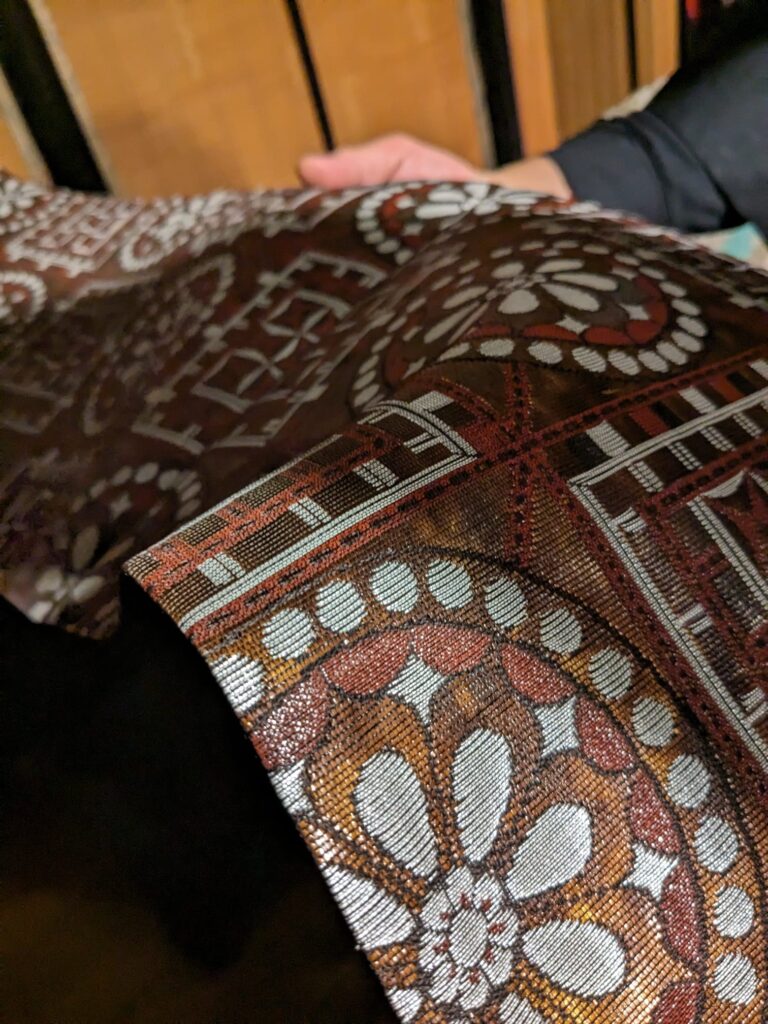
こちらの帯の柄は聖徳太子の宝箱に使われていた文様。生漆を塗り重ねた和紙が使用されています。
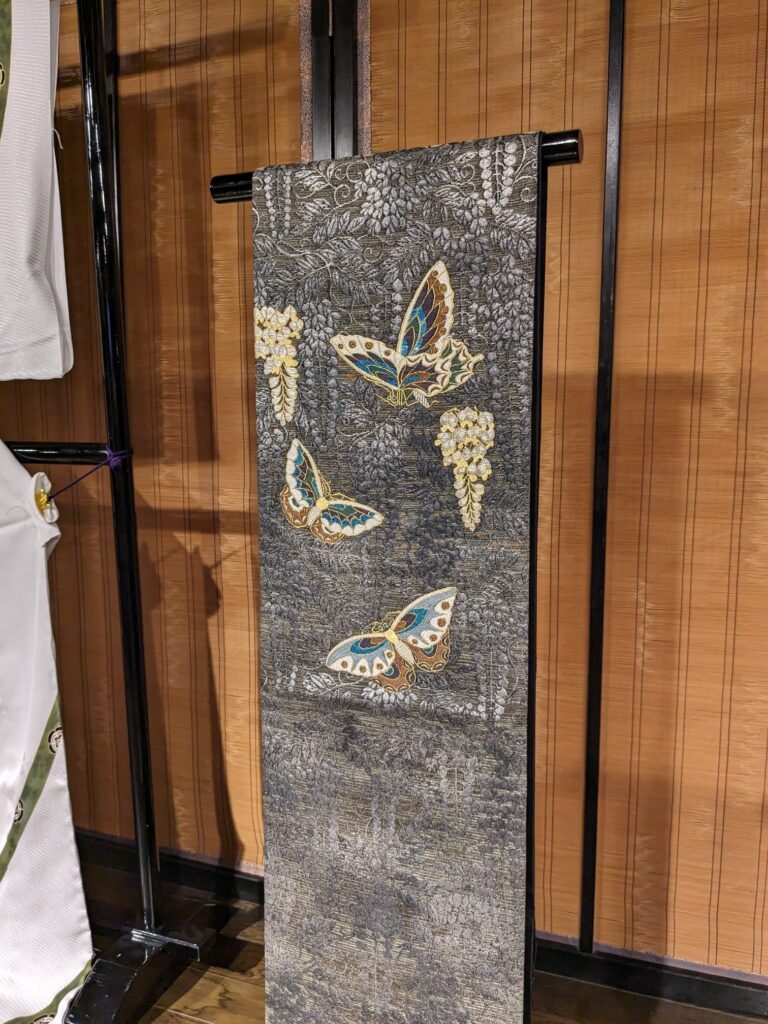

こちらは宝石のオパールを糸にして織られた帯です。このひとつの技術だけでも、長い歳月をかけて作り上げているそう。
帯の説明をしてくださった堀田さん曰く「創業285年の誉田屋源兵衛なので、まるで当たり前のように存在していますが、本来こちらの素材をひとつ作りあげるだけで、普通の会社だったらそれで終わってしまうかもしれない」とのことです。

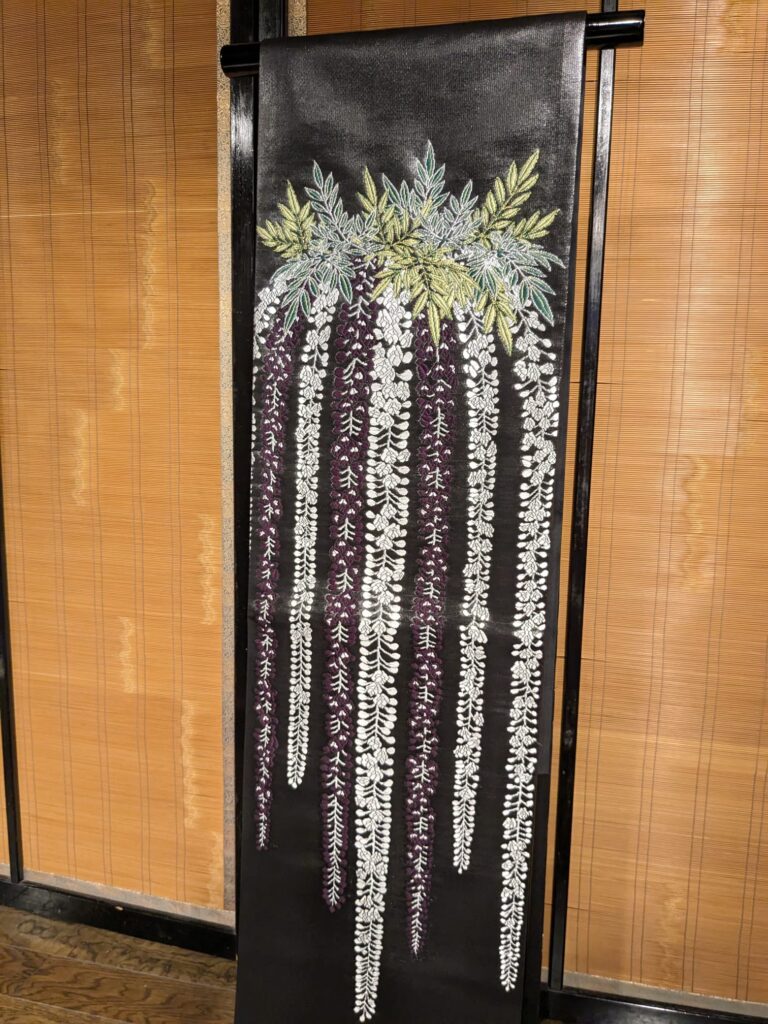
(左)明治の超絶技巧といわれている最高に細かく、高い評価を受けた蒔絵の技術を織物で表現した帯。漆と24金で出来ています。薄い線が全て立体的なので、まるで渦が動いているように見えます。
(右)藤の花を極細の糸で繊細に織られた帯。「唐織」という柄を刺繍のように織り出す浮織の技法で織られる最高級の織物。「唐織」は能に使われる衣装に使われているそうです。
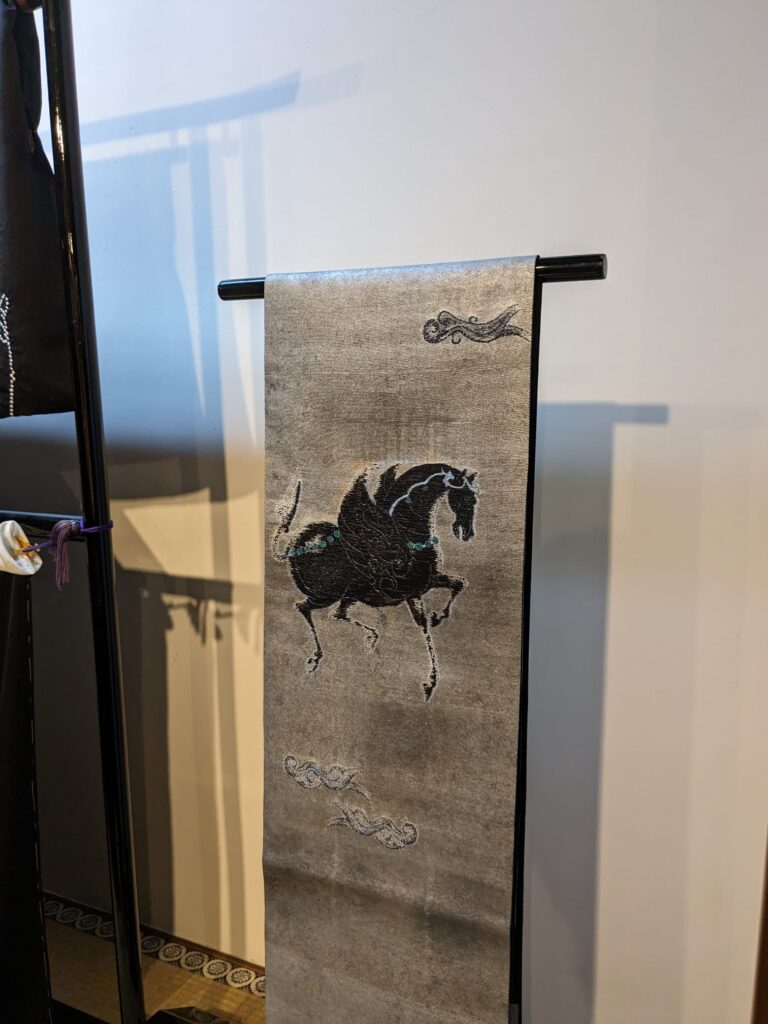
こちらは法隆寺の国宝「竜首水瓶」に描かれた翼をもつ馬「天馬」を表現した帯。よく見ると馬の頭が龍になっています。天馬は「夢を叶える究極の生き物」として紀元前一千年以上に作られた想像上の生きものです。
こちらの帯全体には時を経て変化した本銀の箔を使用。皮をなめし、箔に乗せています。黒い天馬の部分は、漆糸で織られています。
そして馬の胴体の前後に施されている美しい緑色の飾り部分にはオパールが使われています。実物を見ると天馬が浮き出ているような立体感を感じました。
中四国への旅行ならJALで行く格安旅行のJ-TRIP(ジェイトリップ)
![]()
着物姿は帯姿、帯が持つ本来の意味とは?
着物千両、帯万両
着物が主役と思われがちですが「着物姿は帯姿」という言葉があるくらい帯が主役。「見返り美人」はみんな後ろ姿ですよね。そして着物は限りなく無地に近いです。
だから「着物千両、帯万両」という言葉があるわけです。
堀田さんが「帯は自分。後ろの顔といわれている。自分のステイタスであり、自分の表現。自分を安売りしないで。自分を高めてください。」とおっしゃったのが今でも強く印象に残っています。
江戸時代に継続的に発令された奢侈禁止令(贅沢禁止令)
江戸時代に継続的に発令された奢侈禁止令(贅沢禁止令)とは、幕府が発令した「贅沢を禁止して倹約を推奨、強いるための法令」です。武士や町人に対して着物地の種類から染め色まで非常に細かく指定されていました。
しかし帯は法令の対象になっていなかったという説もあるそうです。だから着物がどんどん無地になっていき、その反動で帯が華やかになっていった。帯で自己主張するようになったわけです。
帯は結界、お守り
堀田さんは「帯は結界、お守りでもある。帯を巻いた時点で違う世界の人間なんです。帯を結ぶことで、違う自分がそこに現れる。良い帯を身につけたほうがいい」おっしゃいました。
着物を着る時に帯を結ぶと、背筋が伸びて目が覚める感覚があるのは、この帯が持つ本来の意味があるからなのだと思った瞬間でした。
沖縄旅行ならJALで行く格安旅行のJ-TRIP(ジェイトリップ)
![]()
国宝級のスキルを持つ職人たちが失われてく現実
帯によりますが一本の帯を完成させるのに、源兵衛さんの図案起こしから数えると最低でも1年、2年はかかるそうです。このブログで紹介してきた帯の中には製作期間10年のものもありましたよね。
帯の制作過程にはいくつもの工程があり「誉田屋源兵衛」の帯作りには5〜6人の各工程で非常に優秀な職人の方が集まっています。それに生涯をかけたような人たちが作っている。
「しかし皆さんが80歳ぐらいのご高齢で後継者がいない。それが一番の悩み。こういった職人の仕事は決してお給料は高くないしとても地道です。若い人はしないでしょう。」とおっしゃる堀田さん。
機械で似たような精密で綺麗な織物を織れるかもしれないけど、この味わいを表現するのは不可能です。
日本人として母国のために自分が出来ること
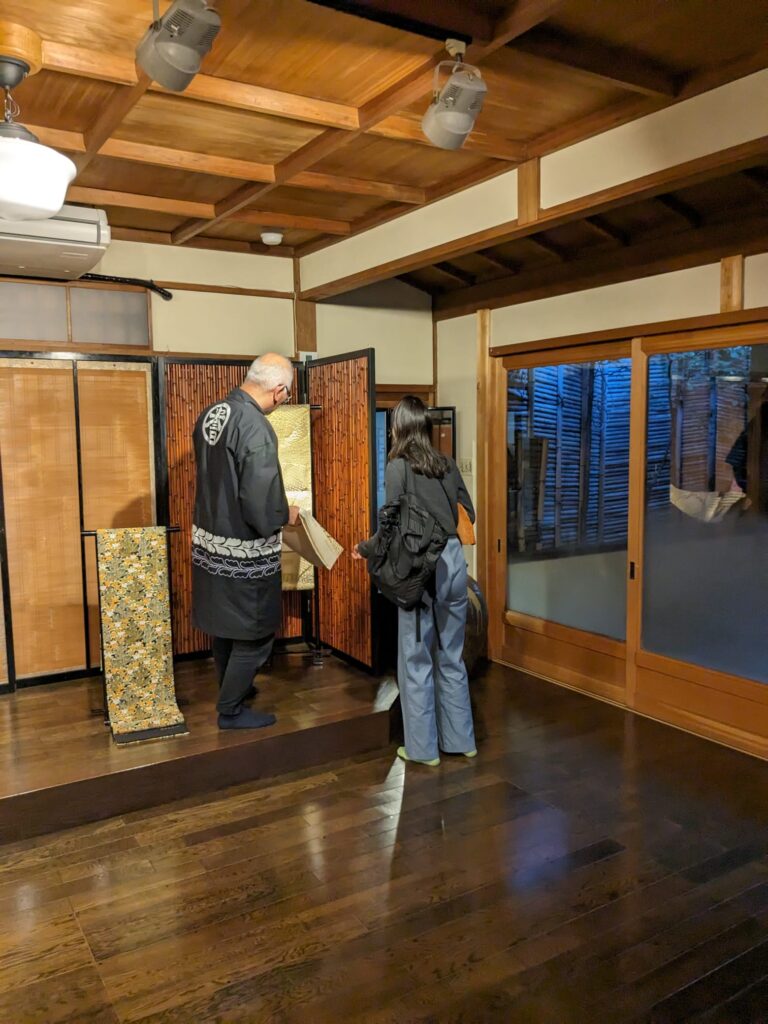
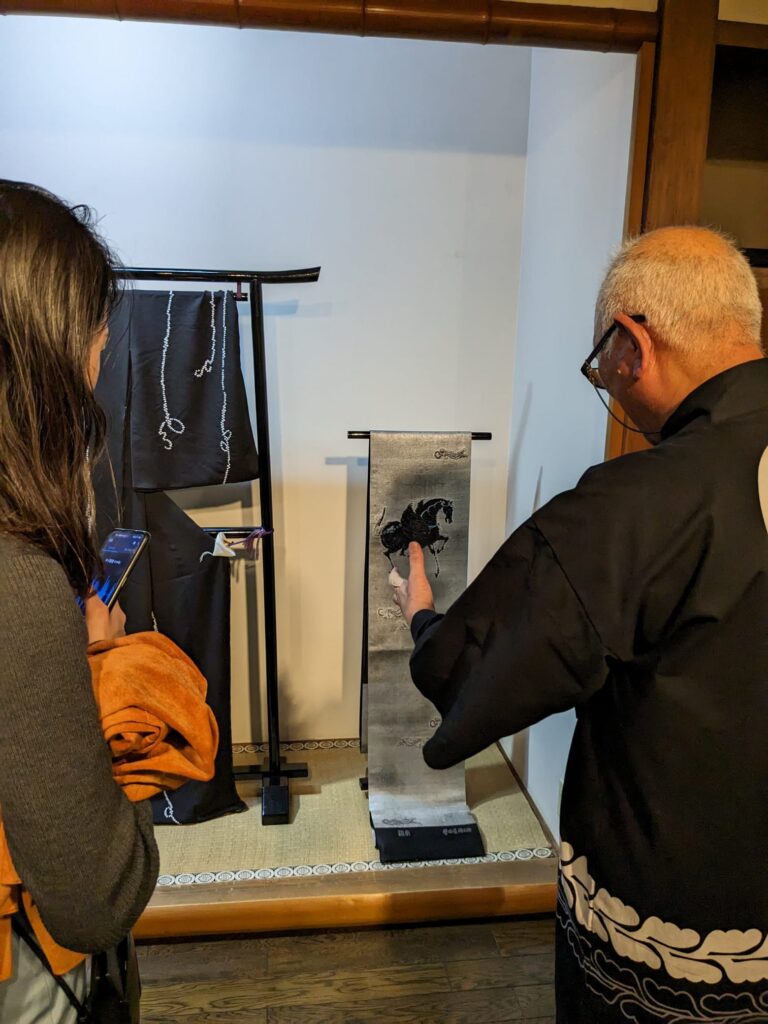
第一弾から第四弾までに至る長編「誉田屋源兵衛」の山口源兵衛さんインタビューと想像を絶する奇跡的な帯たちについて。
私がバンクーバーに住み始めて約2年が経ちます。日本を離れたからこそ「日本の価値と伝統美」を日々感じています。大好きな母国のために自分が出来ることは何だろうと毎日のように考えます。
私にとってはそれが「美しい日本の文化について書いて、伝えること」です。世界中の人に向けて。そして日本中の人に向けて。日本の文化は本当に奥が深く、日本人でも知らないことがまだまだ多いからです。
日本の文化の魅力を新たに知って深く理解する方が少しでも増えることで、失いつつ日本の美しい文化を守る小さな力添えになればと思いながら執筆しています。
一人一人の母国を愛する力は、必ず日本を明るい未来に導くと信じています。
最後に、急な要望にも関わらず長時間のインタビューに応じてくださった山口源兵衛さん、帯について丁寧に説明してくださった堀田さん、「誉田屋源兵衛」のスタッフの皆様に心から感謝致します。
Final Chapter: Unprecedented Miraculous Obi Creations by the 285-Year-Old Obi Craftsman, ‘Kondaya Genbei,’ in Kyoto (Part 2)
I have been conducting interviews with Yamaguchi Genbei, the 10th generation of the 285-year-old establishment, “Kondaya Genbei,” since December. In the first and second installments, we delved into his insights. In the third installment, we introduced the miraculous obis of “Kondaya Genbei” that can be considered national treasures.
Now, in the final chapter – the fourth installment – we will explore topics that were not covered in the previous discussions.
We will delve into the “breathtakingly beautiful obis beyond imagination,” the harsh reality of losing craftsmen with skills at the national treasure level, and the true significance of the kimono attire. Genbei, with fervent admirers both domestically and internationally, continues to introduce groundbreaking works while preserving inherited techniques and traditions. Describing him as the “maverick of the obi industry” would not be an exaggeration.
Visit the official website of ‘Kondaya Genbei’ here: https://kondayagenbei.jp.
During my return to Japan last November, a series of miracles unfolded, providing me with the rare opportunity to witness firsthand obis at the national treasure level and conduct an invaluable interview with Genbei-san.
In the first installment, an interview article with Genbei-san, the 10th generation obi craftsman of the 285-year-old establishment ‘Kondaya Genbei,’ is available at:https://ayakanoikigaidou.com/post-5026/.
Topics covered include ‘Japanese history not found in textbooks,’ ‘the modern tendency to overcomplicate things,’ and ‘the genuine culture of Kyoto and Japan beyond tourist attractions.’
The second installment of the interview series with Genbei-san is accessible at:https://ayakanoikigaidou.com/post-5241/.
It features discussions on ‘Genbei-san’s personal experiences in training at his own temple,’ ‘the encounter with his close friend, Min Tanaka,’ and ‘unexpected hobbies of Genbei-san.’
The third installment, showcasing the miraculous obis beyond imagination in Kyoto, is available at: https://ayakanoikigaidou.com/post-5351/.
Two Obis Depicting Ink Paintings Preserved at the Boston Museum of Fine Arts
This is a representation in textile form of a Chinese ink painting from the Ming Dynasty, the original of which is housed in the Boston Museum of Fine Arts.
It was a challenge to weave something surpassing the beauty of the original ink painting using fabric. The obi belt is infused with silver that has undergone sulfurization over approximately 100 years.
Additionally, threads dyed with ink, with varying shades to depict the ink painting, are woven into the fabric. The threads dyed with lacquer are exclusively used for the carp scales, revealing the gleam of lacquer.
Every single wave is meticulously woven into the fabric. It is an incredibly intricate and delicate textile that is beyond imagination.
And here is an obi belt that takes on the challenge of expressing Chinese ink paintings stored in the Boston Museum of Fine Arts. It seems that Mr. Genbei believes that “as an art form, ink paintings are the ultimate and the best.” Therefore, he is challenging himself to see how far he can express the ultimate work of art through weaving.
This obi also utilizes silver that has undergone sulfurization over approximately 100 years as its base. The distinctive feature of silver is that it initially starts with a beautiful silver color, but over time, it transforms, exhibiting shades of gold, green, and orange before eventually turning black. These two belts, expressing the Chinese ink paintings, allow one to savor the unique process of change inherent in silver. As another 100 years pass, they will likely become even darker, acquiring a more subdued and sophisticated taste. Just as humans age and gain depth, the belts seem to come alive, embodying a truly dynamic quality!
An obi belt that captures the image of peonies seen in the darkness of Nikko Toshogu Shrine, rendered in lapis lazuli
I learned about Mr. Genbei when my partner stumbled upon a YouTube video showcasing one of his obi belts. The moment I saw this belt, I was captivated. It represents the peonies seen in the darkness of a special, usually inaccessible area of Nikko Toshogu Shrine.
To capture a hint of moonlight, silver is deliberately incorporated. Lapis lazuli is used in the woven blue peonies.
An obi belt adorned with the crest of the eleventh shogun of the Tokugawa era, Ienari Tokugawa
This belt is created by dyeing washi paper with lacquer, layering it, and then cutting it into thin threads before weaving the family crest pattern. Normally, lacquer hardens, but the soft finish of this belt is achieved by weaving finely cut lacquered washi paper into it.
Interestingly, lacquer is said to deepen and gain more richness as 100 or 200 years pass. The torn fan portion incorporates platinum and 24-karat gold. The torn fan is a pattern from the battle surcoat (jinbaori) of the eleventh shogun, Ienari Tokugawa, symbolizing the spirit of “never giving up no matter how torn, taking responsibility no matter what happens.”
It is truly a refined and profound expression of determination woven into the battle surcoat with one’s own resolve.
An obi belt that evolves and changes its expression daily, alongside a belt that remains eternal and unchanging
Obi belts dyed with silver or persimmon tannin, as introduced in the previous examples, change over time. They evolve gradually day by day, embodying the essence of “ichi-go ichi-e” – a unique and unrepeatable encounter with each passing day.
Conversely, platinum, 24-karat gold, and shell, as seen in the belts introduced in the previous discussions, remain constant. These belts, such as the one created with “supernatural delicacy using seashells” or the one expressing the art of Ito Jakuchu with platinum, truly embody the concept of unchanging beauty.
Being able to appreciate both the “beauty that changes day by day” and the “eternal beauty” through belts is truly enchanting!
Belts of national treasure caliber exhibited on the first floor
The belts introduced thus far were displayed on the second floor of “Kondaya Genbei.” As captivating as they were, the first floor also showcased an array of national treasure-level belts. I will introduce them one by one in order.
(Left) The base is made from silver that dates back approximately 100 years. The pattern in the foreground incorporates the use of gold.
(Right) Expression of the swirling wind pattern from the glassware of René Lalique, a French jewelry and glass craftsman from the 19th to 20th century. To achieve a three-dimensional effect, soft silk cotton is woven inside while crafting the belt.
This belt is woven with threads made from the gemstone opal. It’s mentioned that just mastering this particular technique alone requires a significant investment of time and effort. According to Mr. Hotta, who explained the belts, “With a history of 285 years, Kondaya Genbei seems to exist as a matter of course, but ordinarily, for a regular company, just creating one of these materials might be considered a considerable accomplishment.”
(Left) A belt that expresses the highly praised and finely detailed technique of maki-e, known for its extraordinary craftsmanship during the Meiji era. This belt is made of lacquer and 24-karat gold. Since every thin line is three-dimensional, it creates the illusion of swirling movement.
(Right) A belt delicately woven with extremely fine threads depicting wisteria flowers. It employs the highest-grade weaving technique known as “Uki-ori,” which weaves the pattern called “Karaori” in an embroidery-like fashion. It is said that “Karaori” is used for costumes in Noh theater.
This obi belt represents the winged horse, “Tenma,” depicted in the national treasure “Dragon-Headed Water Bottle” at Horyu-ji Temple. Upon closer inspection, the horse’s head transforms into a dragon. The Tenma is an imaginative creature created over a thousand years ago as the “ultimate creature that fulfills dreams.”
The entire belt utilizes silver leaf that has changed over time. The silver leaf is applied after tanning the leather. The black portion of the Tenma is woven with lacquered threads.
The beautiful green decorative parts on either side of the horse’s torso incorporate opals. When seen in person, the belt imparts a three-dimensional sensation, making the Tenma appear as if it is emerging from the surface.
The attire of a kimono involves the style of the obi, and what is the inherent meaning of the obi?
Kimono is a thousand ryo, obi is ten thousand ryo
While kimonos are often considered the main focus, the phrase “Kimono is the body, but the obi is the soul” underscores the prominence of the obi. After all, the allure of the “beautiful back” is a well-known concept, and kimonos tend to be more subdued, often resembling plain fabric. Hence, the saying “A kimono is worth a thousand gold pieces, but an obi is worth ten thousand gold pieces.”
Mr. Hotta’s statement, “The obi is yourself. It’s referred to as the back of your face. It represents your status and your expression. Don’t undersell yourself. Elevate yourself,” remains a strong and lasting impression.
The continuous issuance of sumptuary laws, known as the “Luxury Prohibition Edict”
During the Edo period, was a set of regulations imposed by the shogunate to “forbid extravagance, promote frugality, and enforce thriftiness.” It intricately specified everything from the types of fabric for kimono to the colors used for dyeing, targeting both samurai and townspeople.
Interestingly, there is a theory that obis were not included in the scope of these regulations. As a result, kimonos gradually became more plain, leading to a counterreaction where obis became more ornate. This shift marked a period where obis started to assert individuality and extravagance.
The obi is a boundary, a protective charm
Mr. Hotta mentioned, “The obi is a boundary, also a protective charm. The moment you wrap the obi, you become a different person in a different world. By tying the obi, a different version of yourself emerges. It’s better to wear a good obi.”
When tying the obi while wearing a kimono, there’s a sensation of the spine straightening and awakening. I realized that this comes from the inherent meaning that the obi carries.
The harsh reality is the loss of artisans with national treasure-level skills.
Depending on the obi, it takes at least a year or two to complete a single obi, starting from Mr. Genbei’s design concept. As seen in this blog, some obis have taken a decade to produce.
The process of making an obi involves multiple steps, and “Hommataya Genbei” gathers highly skilled artisans at each stage, totaling 5 to 6 individuals. These craftsmen dedicate their entire lives to this craft.
“However, they are all around 80 years old, and there are no successors. That’s the biggest concern. Jobs like these for artisans don’t pay well, and they are very diligent. Young people wouldn’t take up such work,” says Mr. Hotta. While machines might be able to produce similar precise and beautiful textiles, capturing the essence and flavor of these handmade items is impossible.
What I Can Do as a Japanese for My Homeland
As a Japanese living in Vancouver for about two years now, I find myself contemplating what I can do for my beloved homeland every day. The extensive interviews with Mr. Yamaguchi Genbei in the first to fourth installments and the miraculous obis have been truly inspiring.
For me, the answer to what I can contribute for the sake of my country is “writing and sharing about the beautiful culture of Japan.” This is directed towards people worldwide and within Japan. Japanese culture is incredibly profound, and there are still many aspects even Japanese people might not be aware of.
By introducing and deepening the understanding of the charm of Japanese culture to a wider audience, I hope to contribute in a small way to preserving the beauty of Japan’s culture, which is slowly being lost. I believe that the love each individual has for their homeland will inevitably guide Japan towards a bright future.
Finally, I express my sincere gratitude to Mr. Yamaguchi Genbei for generously participating in the lengthy interview despite the sudden request, to Mr. Hotta for explaining the obis in detail, and to all the staff at “Kondaya Genbei” for their cooperation.
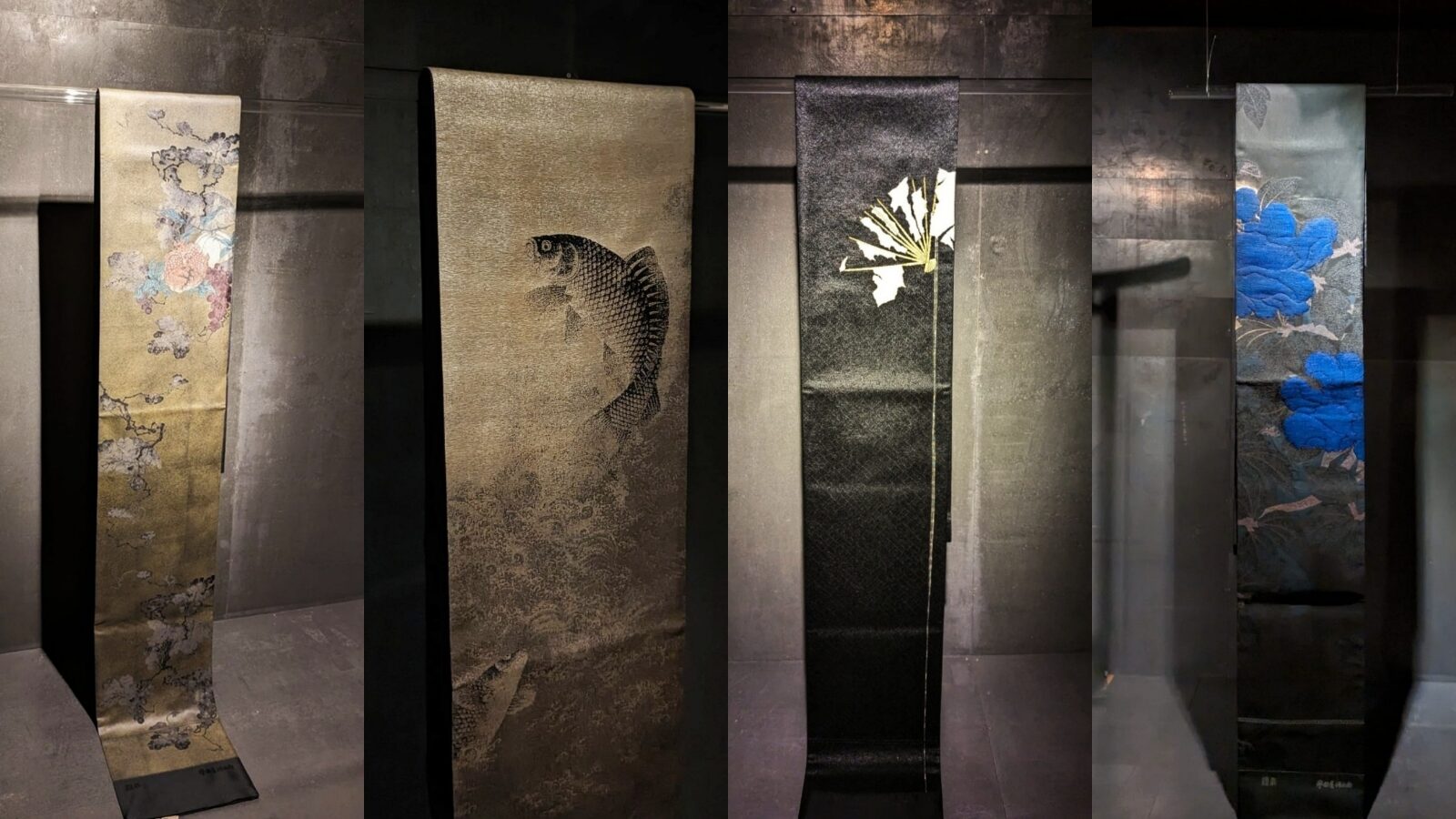
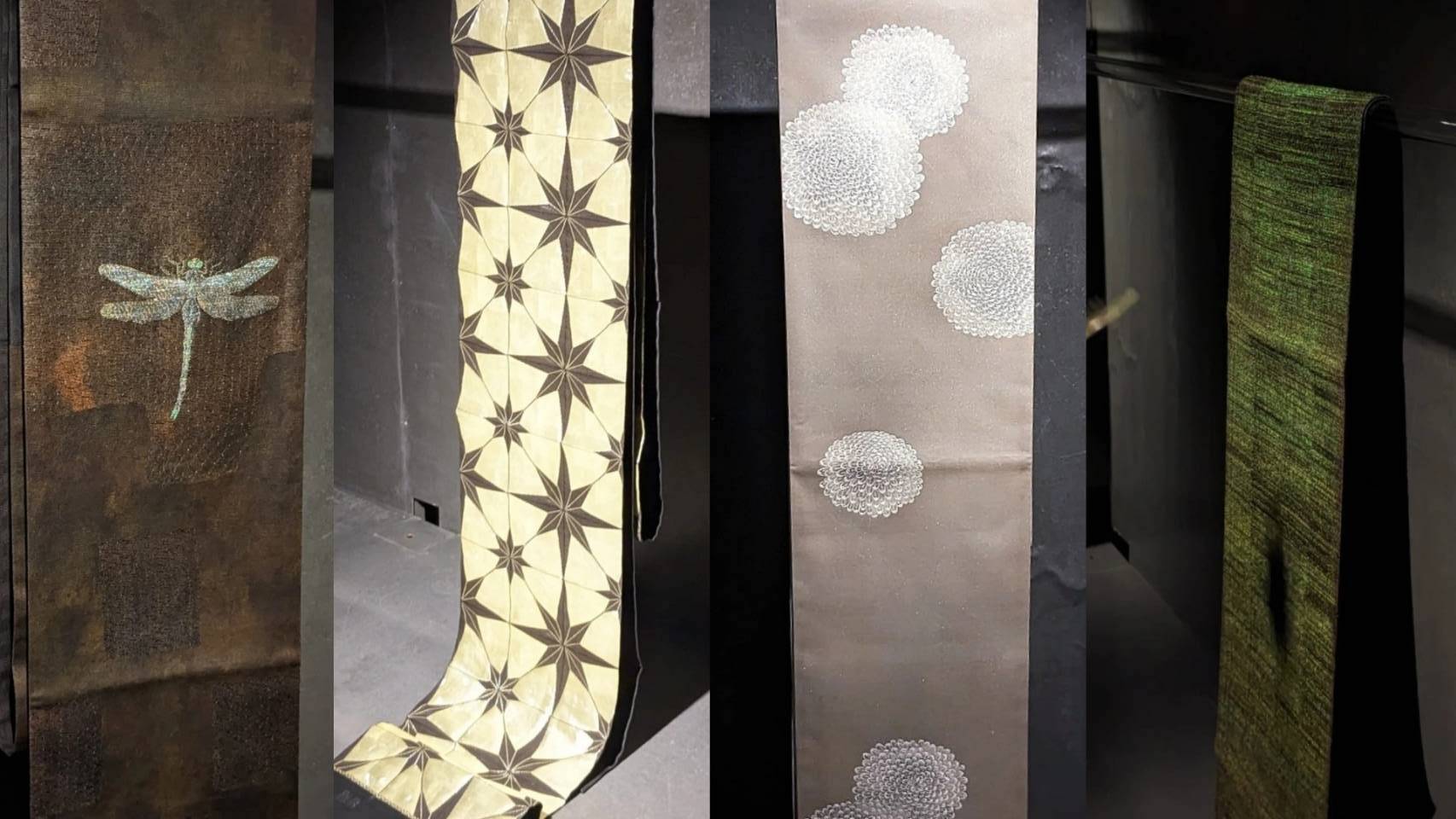
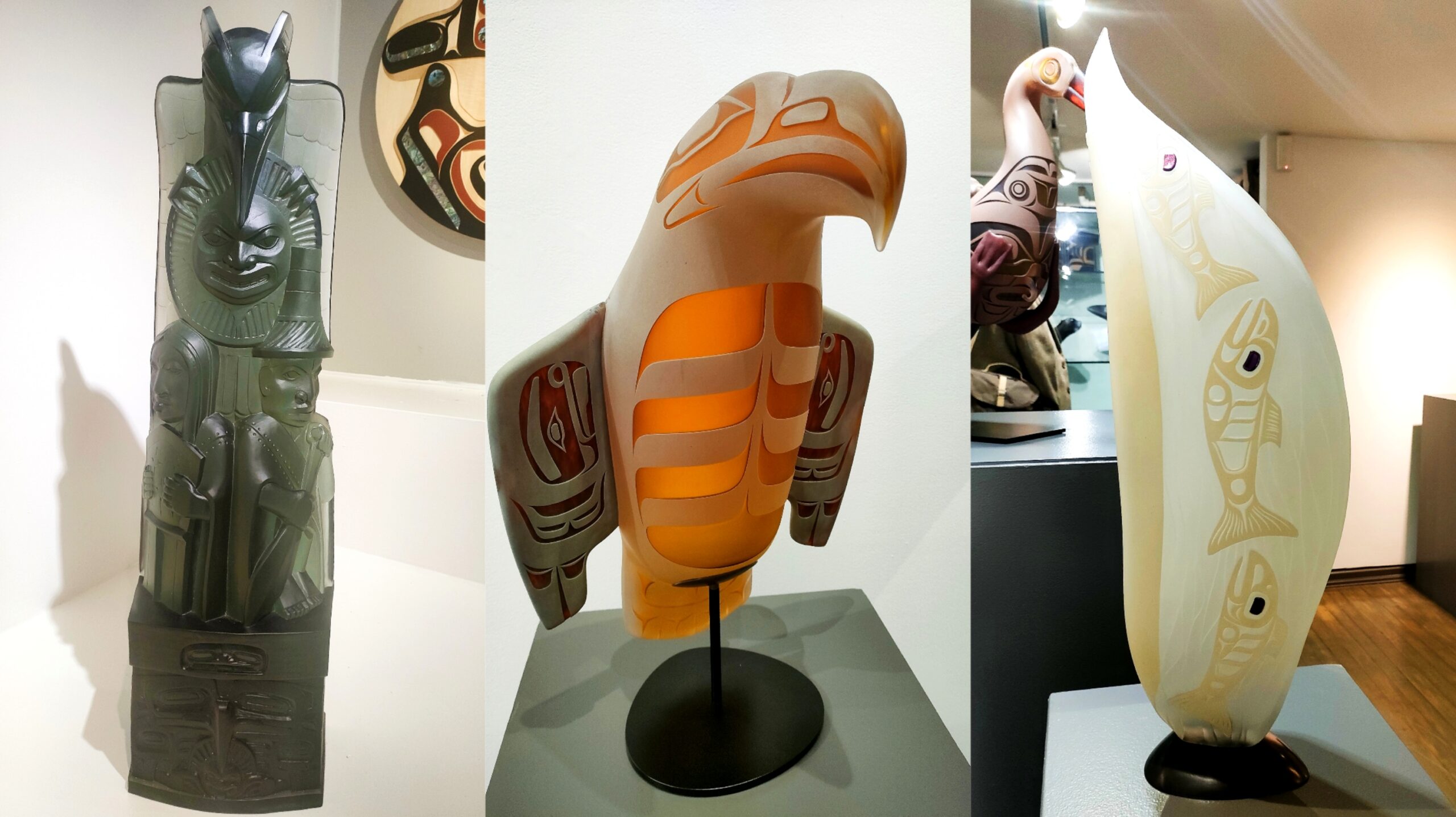
コメント